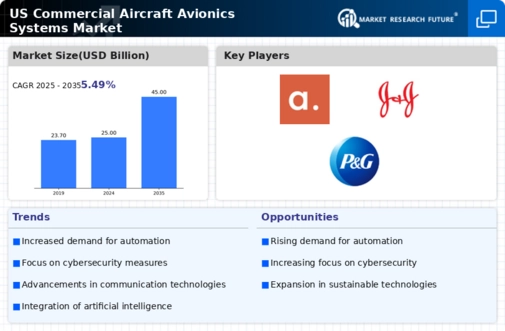Increased Demand for Air Travel
The commercial aircraft-avionics-systems market is experiencing a notable surge in demand for air travel, driven by a growing middle class and increased disposable income in the United States. As more individuals opt for air travel, airlines are compelled to expand their fleets and enhance their operational efficiency. This expansion necessitates the integration of advanced avionics systems, which are crucial for navigation, communication, and safety. According to the Federal Aviation Administration (FAA), the number of commercial flights is projected to increase by approximately 3.5% annually over the next decade. Consequently, this rising demand is likely to stimulate investments in avionics technologies, thereby propelling growth in the commercial aircraft-avionics-systems market.
Growing Focus on Fuel Efficiency
Fuel efficiency is a critical concern for airlines, influencing their operational costs and environmental impact. The commercial aircraft-avionics-systems market is responding to this focus by developing avionics systems that optimize fuel consumption through advanced flight management systems. These systems utilize real-time data to adjust flight paths and reduce fuel usage, aligning with airlines' sustainability goals. The FAA has reported that improving fuel efficiency can lead to savings of up to $1.5 million per aircraft annually. As airlines strive to reduce their carbon footprint and operational expenses, the demand for innovative avionics solutions that enhance fuel efficiency is likely to grow, thereby driving the commercial aircraft-avionics-systems market.
Integration of Artificial Intelligence
The integration of artificial intelligence (AI) into avionics systems is emerging as a transformative driver for the avionics market. AI technologies are being utilized to enhance decision-making processes, optimize flight operations, and improve predictive maintenance. By analyzing vast amounts of data, AI can identify potential issues before they escalate, thereby reducing downtime and operational costs. The market for AI in aviation is expected to grow at a CAGR of approximately 15% over the next five years. This trend indicates a shift towards more intelligent and automated systems, which could significantly enhance the efficiency and reliability of commercial aircraft operations, thereby impacting the commercial aircraft-avionics-systems market positively.
Emergence of Urban Air Mobility Solutions
The concept of urban air mobility (UAM) is gaining traction, presenting new opportunities for the commercial aircraft-avionics-systems market. As cities seek innovative solutions to address congestion and improve transportation efficiency, UAM is being explored as a viable alternative. This shift is prompting the development of new avionics systems tailored for urban environments, including autonomous flight capabilities and advanced navigation systems. The FAA is actively working on regulatory frameworks to support UAM initiatives, which could lead to a market expansion valued at $XX billion by 2035. The integration of these advanced systems into urban air mobility solutions is likely to create a new segment within the commercial aircraft-avionics-systems market, fostering innovation and growth.
Advancements in Safety and Security Technologies
Safety and security remain paramount in the aviation industry, influencing the commercial aircraft-avionics-systems market significantly. Recent advancements in avionics technologies, such as enhanced surveillance systems and automated safety protocols, are being adopted to mitigate risks and ensure passenger safety. The FAA has mandated the implementation of NextGen technologies, which aim to modernize air traffic management and improve safety standards. This regulatory push is expected to drive investments in avionics systems, with the market projected to reach $XX billion by 2030. As airlines prioritize safety, the demand for sophisticated avionics solutions is likely to increase, further bolstering the commercial aircraft-avionics-systems market.














Leave a Comment